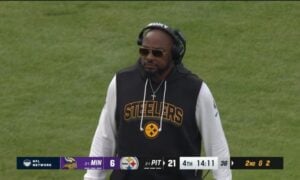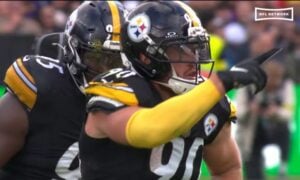From BLESTO to Bradshaw, a new Steelers book has you covered from the years leading up to and including the one in which Pittsburgh won the first of its four Lombardi Trophies in the 1970s.
Steve Massey constructs how the Steelers built a dynasty brick by brick in “Revolution: The Transformation of the Pittsburgh Steelers and the NFL:” Massey’s second Steelers book, which is available on Amazon, is chock full of history and anecdotes, and it has a doozy when it comes to Terry Bradshaw.
One that could have altered the fate of two franchises.
Plenty of teams reached out to the Steelers after a coin flip (and a one-win season in 1969) gave them the first pick in the 1970 NFL Draft, Massey writes. The Steelers became intrigued with one offer after they had taken Bradshaw.
The St. Louis Cardinals put together a package of players that included future Pro Football Hall of Fame CB Roger Wehrli, Massey writes. They added their first-round pick to the offer, which was No. 8 overall, after the Steelers selected Bradshaw.
“The Steelers sent word back, ‘If Mike Reid is available, we’ll talk,’” Massey told Steelers Depot earlier this week. “The Bengals took him, and they were one pick ahead of the [Cardinals]. That was that and the deal was off.”
Massey spent six years working on Revolution and put countless hours of research into it. The bibliography alone is more than 70 pages. He also interviewed almost a dozen people, including Art Rooney Jr.
Rooney is one of the chief architects of the Steelers’ 1970s dynasty for his work in the drafts that built it. Along with Rooney and the exalted Bill Nunn, Massey fleshes out the stories of lesser-known scouts who were critical to the Steelers’ transformation from perennial also-rans to world champions, and BLESTO’s role in that rise.
The same is true of assistant coaches who don’t get the acclaim of Chuck Noll for their work in developing players such as CB Mel Blount.
Here is an excerpt from the book that covers it all from 1969-74 (Editor’s note: quotes used in this excerpt are sourced in the book).
Melvin Blount’s scouting reports glowed.
His coaches say he hits, and I saw him crack a kid in practice…Perfect size and speed …Very tall and rangy but still moves feet well…covered man-to-man well and they have some fast kids here…I’d like to say for sure he could be a cornerback, but I don’t know how he would do with a guy like [Roy] Jefferson…Maybe I am too cautious about this. Projection: Potential starter, second-round pick
As a collegiate playing in relative obscurity in the segregated South, Bill Nunn found him. When drafted, Mel Blount had never played zone in his life. Charlie Sumner and Bud Carson coached him through early struggles. Most importantly, he contributed to the Steeler revolution by changing the rules of the game itself.
The Steelers picked him in the third round of the 1970 draft, and he was not too happy about it. He thought he should have been a first-round choice.
“I was down in Baton Rouge at Southern University, and I wanted to play for the [New Orleans] Saints,” Blount said. “Being a southern boy, I didn’t know anything about Pittsburgh, or the people involved in it. But, as it turned out, it was one of the best things that ever happened to me.”
He collaborated with his patient assistant coaches: Charlie Sumner, Woody Widenhofer, and Bud Carson, who helped transform him after early, difficult seasons. Blount, looking back, gave a self-assessment that he was a raw talent but gave credit to his coaches.
“When I was in college, we played man-to-man, and that’s why, in my opinion, I was a great bump-and-run guy,” he said. “So, when I came to the Steelers, I had to learn how to play zone, where you had to play in a zone instead of running out of it, chasing a receiver. I had to learn all that. Charlie Sumner started to teach me that, and after Charlie, we had Bud Carson. I think I learned more football from a defensive perspective because he was a great defensive mind.”
Blount recalled meeting Sumner early in the summer of his rookie year. Sumner drew a diagram of a simple zone defense on the blackboard and told Mel to identify the formation. Blount didn’t know what the diagram was. In college, he was taught to simply pick a man and cover him. The road ahead was long.
Blount, like all his secondary mates, learned what formations and zones to play as soon as their opponents lined up. After his first two years, during which he made many mistakes, some of which were broadcast to national TV audiences, he evaluated his playing time and opportunities for improvement. He realized how a lack of processing plays and keys (habits that tip off an opponent’s intentions) had suckered him into bad choices. In the summer of 1972, he decided to swallow his pride and commit himself to learning.
He punished smaller receivers mercilessly. Mel Blount entered the league at a perfect time, as receivers were typically around 5-11 and were fast. Mel was set up for them because he was so big. If he made mistakes, he could recover with his speed
At Steelers camp in 1974, rookies [Lymm] Swann and [John] Stallworth reported to camp during the players’ strike. Assistant coach Lionel Taylor told them they wouldn’t be able to handle Mel Blount once he arrived. Stallworth first laid eyes on the man at a preseason game.
“My jaw hit the ground,” he said. “No, he can’t be a cornerback, not that big.”
At practice, he singled out Stallworth in drills. Stallworth talked back to him. Blount would line up in Stallworth’s face.
“He couldn’t scare me anything worse than what I was already feeling. If Mel would have spread his arms, it would have looked like they had gone forever,” Stallworth said. “This man across from me knows exactly what he is doing. I, on the other hand, don’t.”
Both men, found by Nunn, advocated for by BLESTO, coached by the staff, found their way to the Hall of Fame.
Bud Carson and Blount immediately butted heads. Initially, Blount took press criticism hard, causing him to doubt his abilities. He decided that “a man has to believe in himself.” He said, as early as 1973, that Bud Carson was not so bad after all.
“He’s the one person who gave me something no one on the staff ever did,” Blount said. “He helped me believe in myself. It was like I found that little something I’d been missing.”
As the years passed, Blount came to believe that Bud Carson was the best coach he had ever had.
In the 1974 AFC Championship Game, Blount had trouble covering Oakland’s Cliff Branch, who scored on a touchdown pass as he “finessed” Blount. In his own words, his speed betrayed him. Branch had a monster game, catching nine passes for nearly 200 yards. Blount was taken out of the game and replaced by rookie Jim Allen. He was humiliated and angry when Carson took him out. In fact, Carson did not speak to him after telling him he was benched.
Blount implied that Bud Carson was stupid for benching him, but he later called the game “a turning point in his career.” Carson, he reflected, had molded him into the player he was
“Looking back, he handled it better than any other coach would have because he just went on with business as usual, which really says a lot about him,” Blount said.








